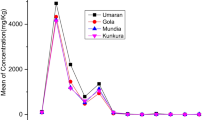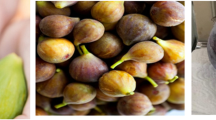Abstract
The chemical composition and antioxidant activities of the Korean cactus (Opuntia humifusa, OH) fruit were investigated in this study. Major minerals in the OH fruit were P, Ca, and Mg. Total dietary fiber content was 22.8% and the soluble dietary fiber/insoluble dietary fiber ratio was 1:1.3. An 80% ethanol extract was used to investigate antioxidant activities based on DPPH radical scavenging ability as well as total phenolic and flavonoid content. OH fruit extract from 80% ethanol was sequentially fractionated according to the polarity of solvents. Among various fractions, the ethyl acetate fraction showed the highest antioxidant activity as well as the highest total phenolic and total flavonoid contents compared to other fractions. The most abundant phenolic acid in the ethyl acetate fraction was ferulic acid, followed by protocatechuic acid. The most abundant flavonoid was taxifolin, followed by myricetin. The results suggested that OH fruit could be a good potential source of antioxidant.
Similar content being viewed by others
References
Chang SF, Hsieh, Yen GC. The protective effect of Opuntia dillenii fruit against low-density lipoprotein peroxidation and its active compounds. Food Chem. 106: 569–575 (2008)
Zhang XK, Jin X, Lai FY, Lin QS, Jiang JG. Chemical analysis and antioxidant activities in vitro of polysaccharide extracted from Opuntia ficus indica Mill. cultivated in China. Carbohyd. Res. 82: 722–727 (2010)
Scalbert A, Manach C, Morand C, Remesy C, Jimenez L. Dietary polyphenols and the prevention of diseases. Crit. Rev. Food Sci. 45: 287–306 (2005)
Guevara-Figueroa T, Jiménez-Islas H, Reyes-Escogido ML, Mortensen AG, Laursen BB, Lin LW, Leon-Rodriguez AD, Fomsgaard IS, Rosa AP. Proximate composition, phenolic acids, and flavonoids characterization of commercial and wild nopal (Opuntia spp.). J. Food Compos. Anal. 23: 525–532 (2010)
Lee KS, Oh CS, Lee KY. Antioxidative effect of the fractions extracted from a cactus cheonnyuncho (Opuntia humifusa). Korean J. Food Sci. Technol. 37: 474–478 (2005)
AOAC. Official Methods of Analysis of AOAC Intl, 13th ed. Method 930.04, 930.5, 979.09, 957.13. Association of Official Analytical Chemists, Washington, DC, USA. (1996)
Prosky L, Asp N, Schweizer T, Devries J, Furdal I. Determination of insoluble, soluble, and total dietary fiber in foods products, Interlaboratory study. J. Assoc. Off. Anal. Chem. 71: 1017–1025 (1998)
KFDA. Food Code. Korea Food & Drug Administration, Seoul, Korea. pp. 358–364 (2005)
Dewanto V, Wu X, Adonm KK, Liu RH. Thermal processing enhances the nutritional value of tomatoes by increasing total antioxidant activity. J. Agr. Food Chem. 50: 3010–3014 (2002)
Jia Z, Tang M, Wu J. The determination of flavonoid contents in mulberry and they scavenging effects on superoxide radicals. Food Chem. 64: 555–559 (1999)
Brand-Williams W, Cuvelier ME, Berset C. Use of a free radical method to evaluate antioxidant activity. LWT-Food Sci. Technol. 28: 25–30 (1995)
Arts MJ, Haenen GR, Voss HP, Bast A. Antioxidant capacity of reaction products limits the applicability of the Trolox equivalent antioxidant capacity (TEAC) assay. Food Chem. Toxicol. 42: 45–49 (2004)
Oyaizu M. Studies on products of browning reaction-Antioxidant activities of products of browning reaction prepared from glucosamine. Jpn. J. Nutr. 44: 307–315 (1986)
Jin YC, Liu HL, Yuan K. Simultaneous determination of seven effective constituents in the leaves of bamboo by reversed phase high performance liquid chromatography (RP-HPLC). J. Med. Plants Res. 5: 5630–5635 (2011)
Jung BM, Han KA, Shin TS. Food components of different parts of cheonnyuncho (Opuntia humifusa) harvested from Yeosu, Jeonnam in Korea. J. Korean Soc. Food Sci. Nutr. 40: 1271–1278 (2011)
Hahm SW, Park JE, Son YS. Opuntia humifusa stem lower blood glucose and cholesterol levels in streptozotocin-induced diabetic rats. Nutr. Res. 31: 479–487 (2011)
Yoon JA, Hahm SW, Son YS. Nutrients contents in different parts of pickly pear (Opuntia humifusa) and possible anti-breast cancer effect. Korean J. Food Nutr. 22: 485–491 (2009)
Sánchez-Castillo C, Dewey P, Aguirre A, Lara J, Vaca R, Leon P. The mineral content of Mexican fruits and vegetables. J. Food Compos. Anal. 11: 340–356 (1998)
Lee WTK, Leung SSF, Leung DMY, Wang SH, Xu YC, Zeng WP, Cheng JCY. Bone mineral acquisition in low calcium intake children follow the withdrawal of calcium supplement. Acta Paediatr. 86: 570–576 (1997)
Grigelmo-Miguel N, Martin-Belloso O. Comparison of dietary fiber from byproducts of processing fruits and greens from cereals. LWTFood Sci. Technol. 32: 503–508 (1999)
Bach-Knudsen KE. The nutritional significance of “dietary fibre” analysis. Anim. Feed Sci. Tech. 90: 3–20 (2001)
Alothman M, Bhat R, Karim AA. Antioxidant capacity and phenolic content of selected tropical fruits from Malaysia, extracted with different solvents. Food Chem. 115: 785–788 (2009)
Kuti JO. Antioxidant compounds from four Opuntia cactus pear fruit varieties. Food Chem. 85: 527–533 (2004)
Cho IK, Seo KS, Kim YD. Antimicrobial activities, antiocidant effects, and total polyphenol contents of extracts of prickly pear, Opuntia ficus indica. Korean J. Food Preserv. 16: 953–958 (2009)
Yoon JA, Hahm SW, Park JE, Son YS. Total polyphenol and flavonoid of fruit extract of Opuntia humifusa and its inhibitory effect on the growth of MCF-7 human breast cancer cells. J. Korean Soc. Food Sci. Nutr. 38: 1679–1684 (2009)
Jun HI, Song GS, Yang EI, Youn Y, Kim YS. Antioxidant activities and phenolic compounds of pigmented rice bran extracts. J. Food Sci. 77: C759–C764 (2012)
Kim HD, Jung JH, Kim SG, Lee HK, Lee SK. Antioxidants and anti-obesity activities of hot water and ethanolic extracts from chenonnyuncho (Opuntia humifusa). Korean J. Food Preserv. 18: 366–373 (2011)
Jung BM, Shin MO, Kim HR. The effect of antimicrobial, antioxidant, and anticancer properties of Opuntia humifusa stems. J. Korean Soc. Food Sci. Nutr. 41: 20–25 (2012)
Repo-Carrasco-Valencia R, Hellstroöm JK, Pihlava JM, Mattila PH. Flavonoids and others phenolic compounds in Andean indigenous grains: Quinoa (Chenopodium quinoa), kañiwa (Chenopodium pallidicaule), and kiwicha (Anaranthus caudatus). Food Chem. 120: 128–133 (2010)
Lee KS, Lee KY. Biological activity of phenol compound from a cactus chenonnyuncho (Opuntia humifusa) in Korea. J. Korean Soc. Food Sci. Nutr. 39: 1132–1136 (2010)
Author information
Authors and Affiliations
Corresponding author
Rights and permissions
About this article
Cite this article
Cha, MN., Jun, HI., Lee, WJ. et al. Chemical composition and antioxidant activity of Korean cactus (Opuntia humifusa) fruit. Food Sci Biotechnol 22, 523–529 (2013). https://doi.org/10.1007/s10068-013-0110-0
Received:
Revised:
Accepted:
Published:
Issue Date:
DOI: https://doi.org/10.1007/s10068-013-0110-0




